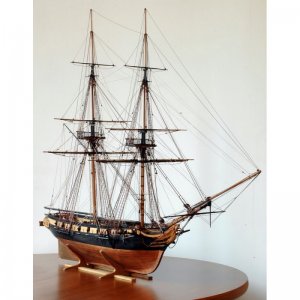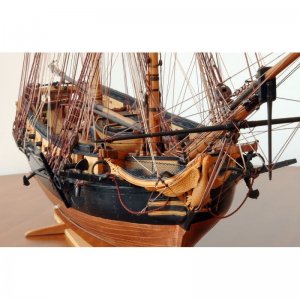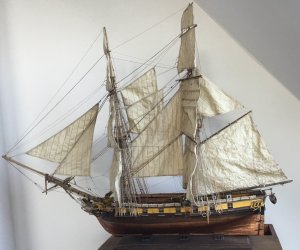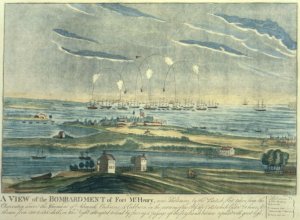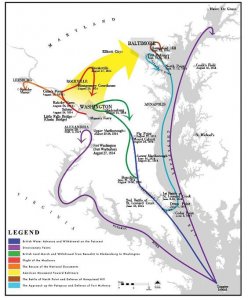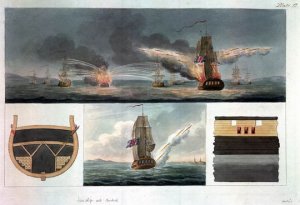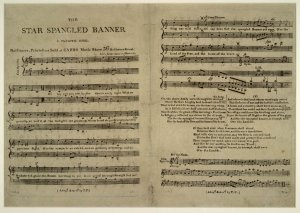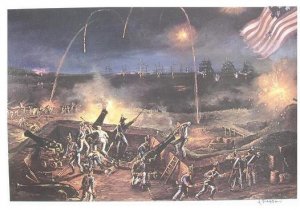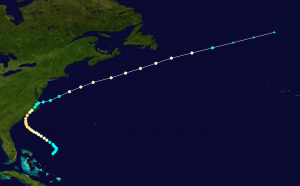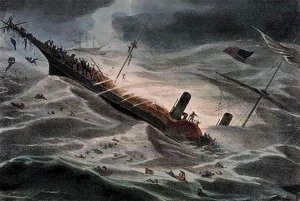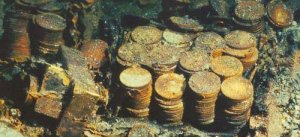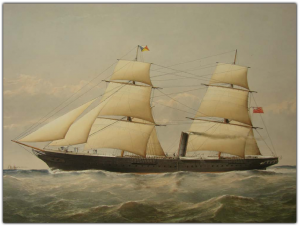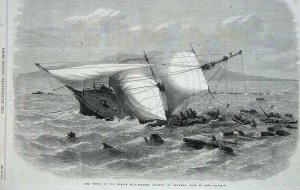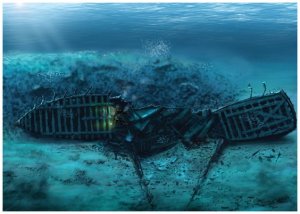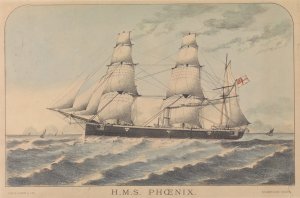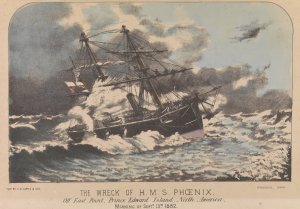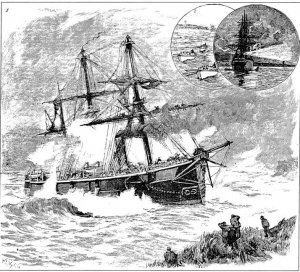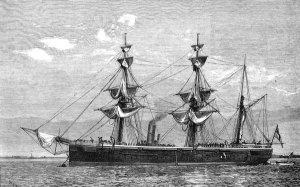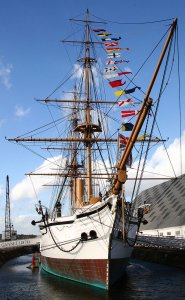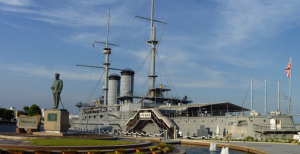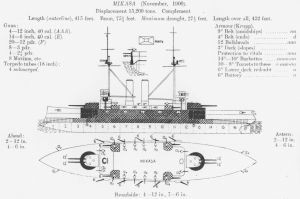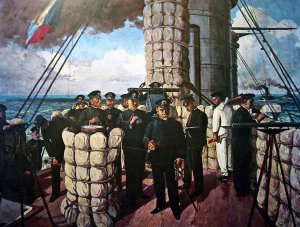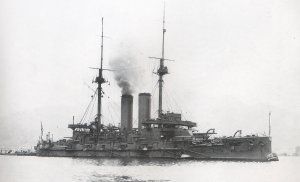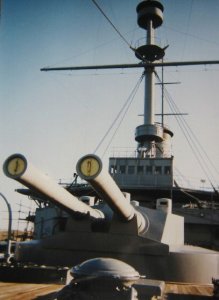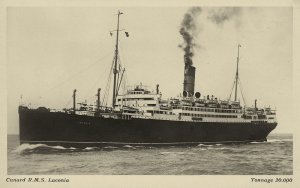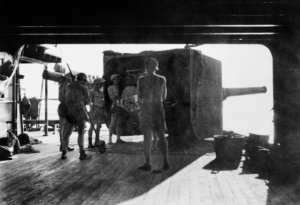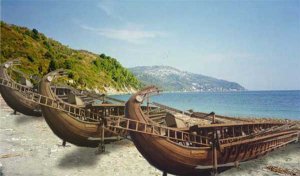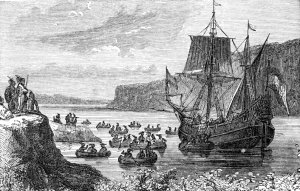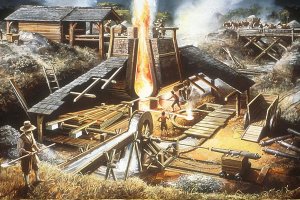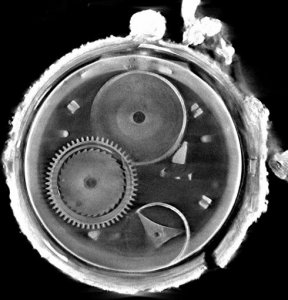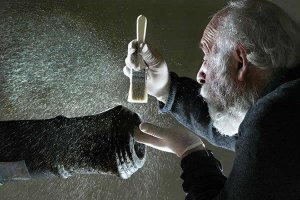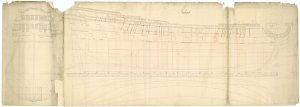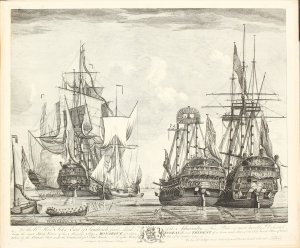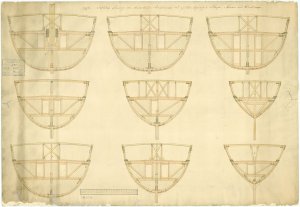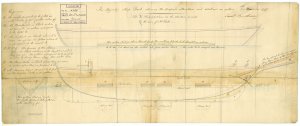Today in Naval History - Naval / Maritime Events in History
11 September 1798 - Launch of HMS Temeraire, a 98-gun ship of the Neptune-class
HMS Temeraire was a 98-gun second-rate ship of the line of the Royal Navy. Launched in 1798, she served during the French Revolutionary and Napoleonic Wars, mostly on blockades or convoy escort duties. She fought only one fleet action, the Battle of Trafalgar, but became so well known for her actions and her subsequent depictions in art and literature that she has been remembered as The Fighting Temeraire.
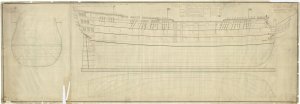
Scale 1:48. Plan showing the body plan, sheer lines, and longitudinal half-breadth for 'Neptune' (1797), and later for 'Temeraire' (1798) and 'Queen' (1805) prior to the latter's lengthening. Alterations dated 1796 illustrated on the plan only apply to 'Neptune' and 'Temeraire', as 'Ocean' was ordered to be lengthened by 11ft 6 inches in July 1797.
Read more at http://collections.rmg.co.uk/collections/objects/80116.html#kwB0B1EJHURurBTq.99
Built at Chatham Dockyard, Temeraire entered service on the Brest blockade with the Channel Fleet. Missions were tedious and seldom relieved by any action with the French fleet. The first incident of note came when several of her crew, hearing rumours they were to be sent to the West Indies at a time when peace with France seemed imminent, refused to obey orders. This act of mutiny eventually failed and a number of those responsible were tried and executed. Laid up during the Peace of Amiens, Temeraire returned to active service with the resumption of the wars with France, again serving with the Channel Fleet, and joined Horatio Nelson's blockade of the Franco-Spanish fleet in Cadiz in 1805. At the Battle of Trafalgar on 21 October, the ship went into action immediately astern of Nelson's flagship, HMS Victory. During the battle Temeraire came to the rescue of the beleaguered Victory, and fought and captured two French ships, winning public renown in Britain.
After undergoing substantial repairs, Temeraire was employed blockading the French fleets and supporting British operations off the Spanish coasts. She went out to the Baltic in 1809, defending convoys against Danish gunboat attacks, and by 1810 was off the Spanish coast again, helping to defend Cadiz against a French army. Her last action was against the French off Toulon, when she came under fire from shore batteries. The ship returned to Britain in 1813 for repairs, but was laid up. She was converted to a prison ship and moored in the River Tamar until 1819. Further service brought her to Sheerness as a receiving ship, then a victualling depot, and finally a guard ship. The Admiralty ordered her to be sold in 1838, and she was towed up the Thames to be broken up.
This final voyage was depicted in a J. M. W. Turner oil painting greeted with critical acclaim, entitled The Fighting Temeraire tugged to her last Berth to be broken up, 1838. The painting continues to be held in high regard and was voted Britain's favourite painting in 2005.
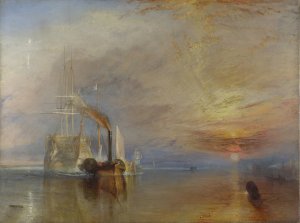
The Fighting Temeraire tugged to her last berth to be broken up, 1838 by J. M. W. Turner, 1838
Construction and commissioning
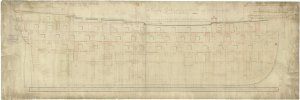
Admiralty plan for a 98-gun ship of the line of the Neptune class. This represents the design for HMS Dreadnought, drawn up by the Navy Office and dated 22 July 1789.
Temeraire was ordered from Chatham Dockyard on 9 December 1790, to a design developed by Surveyor of the Navy Sir John Henslow. She was one of three ships of the Neptune class, alongside her sisters HMS Neptune and HMS Dreadnought. The keel was laid down at Chatham in July 1793. Her construction was initially overseen by Master Shipwright Thomas Pollard and completed by his successor Edward Sison. Temeraire was launched on 11 September 1798 and the following day was taken into the graving dock to be fitted for sea. Her hull was fitted with copper sheathing, a process that took two weeks to complete. Refloated, she finished fitting out, and received her masts and yards.

Scale 1:48. Plan showing the bow inboard side elevation, stern quarter inboard elevation, a section through the bow at Station 24, and a section through the stern at Station Q for 'Temeraire' (1798), and later for 'Neptune' (1797), and 'Dreadnought' (1801), all 98-gun Second Rate, three-deckers. The plan also related to 'Ocean' (1805), prior to being lengthened 11 feet in 1797 to accommodate larger calibre cannon. A version of this plan with alterations in green ink was dispatched to the various royal yards in March 1792. The plan illustrates the proposed (and approved with alterations) manner of erecting a roof over the fore and aft part of the ship to protect it from the weather during construction.
She was commissioned on 21 March 1799 under Captain Peter Puget, becoming the second ship of the Royal Navy to bear the name Temeraire. Her predecessor had been the 74-gun third-rate HMS Temeraire, a former French ship taken as a prize at the Battle of Lagos on 19 August 1759 by a fleet under Admiral Edward Boscawen. Puget was only in command until 26 July 1799, during which time he oversaw the process of fitting the new Temeraire for sea. He was superseded by Captain Thomas Eyles on 27 July 1799, while the vessel was anchored off St Helens, Isle of Wight.
Battle of Trafalgar
Temeraire duly received orders to join the Cadiz blockade, and having sailed to rendezvous with Collingwood, Harvey awaited Nelson's arrival. Nelson's flagship, the 100-gun HMS Victory, arrived off Cadiz on 28 September, and he took over command of the fleet from Collingwood. He spent the next few weeks forming his plan of attack in preparation for the expected sortie of the Franco-Spanish fleet, issuing it to his captains on 9 October in the form of a memorandum. The memorandum called for two divisions of ships to attack at right angles to the enemy line, severing its van from the centre and rear. A third advance squadron would be deployed as a reserve, with the ability to join one of the lines as the course of the battle dictated. Nelson placed the largest and most powerful ships at the heads of the lines, with Temeraire assigned to lead Nelson's own column into battle. The fleet patrolled a considerable distance from the Spanish coast to lure the combined fleet out, and the ships took the opportunity to exercise and prepare for the coming battle. For Temeraire this probably involved painting her sides in the Nelson Chequer design, to enable the British ships to tell friend from foe in the confusion of battle.
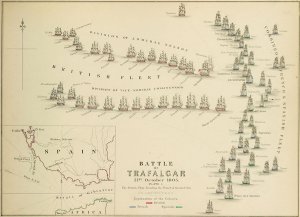
An 1848 plan of the fleet positions at the Battle of Trafalgar. Temeraireforms part of the weather column, and is depicted abreast of the Victory, racing her for the Franco-Spanish line.
The combined Franco-Spanish fleet put to sea on 19 October 1805, and by 21 October was in sight of the British ships. Nelson formed up his lines and the British began to converge on their distant opponents. Contrary to his original instructions, Nelson took the lead of the weather column in Victory. Concerned for the commander-in-chief's safety in such an exposed position, Henry Blackwood, a long-standing friend of Nelson and commander of the frigate HMS Euryalus that day, suggested that Nelson come aboard his ship to better observe and direct the battle. Nelson refused, so Blackwood instead tried to convince him to let Harvey come past him in the Temeraire, and so lead the column into battle. Nelson agreed to this, and signalled for Harvey to come past him. As Temeraire drew up towards Victory, Nelson decided that if he was standing aside to let another ship lead his line, so too should Collingwood, commanding the lee column of ships. He signalled Collingwood, aboard his flagship HMS Royal Sovereign, to let another ship come ahead of him, but Collingwood continued to surge ahead. Reconsidering his plan, Nelson is reported to have hailed the Temeraire, as she came up alongside Victory, with the words "I'll thank you, Captain Harvey, to keep in your proper station, which is astern of the Victory". Nelson's instruction was followed up by a formal signal and Harvey dropped back reluctantly, but otherwise kept within one ship's length of Victory as she sailed up to the Franco-Spanish line.
Closely following Victory as she passed through the Franco-Spanish line across the bows of the French flagship Bucentaure, Harvey was forced to sheer away quickly, just missing Victory's stern. Turning to starboard, Harvey made for the 140-gun Spanish ship Santísima Trinidad and engaged her for twenty minutes, taking raking fire from two French ships, the 80-gun Neptune and the 74-gun Redoutable, as she did so. Redoutable's broadside carried away Temeraire's mizzen topmast. While avoiding a broadside from Neptune, Temeraire narrowly avoided a collision with Redoutable. Another broadside from Neptune brought down Temeraire's fore-yard and main topmast, and damaged her fore mast and bowsprit. Harvey now became aware that the Redoutable had come up alongside the Victory and swept her decks with musket fire and grenades. A large party of Frenchmen now gathered on her decks ready to board the Victory. Temeraire was brought around; appearing suddenly out of the smoke of the battle and slipping across Redoutable's stern, Temeraire discharged a double-shotted broadside into her. Jean Jacques Étienne Lucas, captain of the Redoutable, recorded that "... the three-decker [Temeraire] – who had doubtless perceived that the Victory had ceased fire and would inevitably be taken – ran foul of the Redoutableto starboard and overwhelmed us with the point-blank fire of all her guns. It would be impossible to describe the horrible carnage produced by the murderous broadside of this ship. More than two hundred of our brave lads were killed or wounded by it."
Temeraire and Redoutable
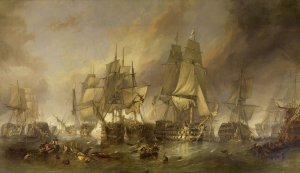
The Battle of Trafalgar, 1836 oil on canvas by Clarkson Frederick Stanfield. Stanfield shows the damaged Redoutable caught between the Victory (foreground) and the Temeraire (seen bow on). The Fougueux, coming up on Temeraire's starboard side, has just received a broadside.
Temeraire then rammed into the Redoutable, dismounting many of the French ship's guns, and worked her way alongside, after which her crew lashed the two ships together. Temeraire now poured continuous broadsides into the French ship, taking fire as she did so from the 112-gun Spanish ship Santa Ana lying off her stern, and from the 74-gun French ship Fougueux, which came up on Temeraire's un-engaged starboard side. Harvey ordered his gun crews to hold fire until Fougueux came within point blank range. Temeraire's first broadside against Fougueux at a range of 100 yards caused considerable damage to the Frenchman's rigging, and she drifted into Temeraire, whose crew promptly lashed her to the side. Temeraire was now lying between two French 74-gun ships. As Harvey later recalled in a letter to his wife "Perhaps never was a ship so circumstanced as mine, to have for more than three hours two of the enemy's line of battle ships lashed to her." Redoutable, sandwiched between Victory and Temeraire, suffered heavy casualties, reported by Captain Lucas as amounting to 300 dead and 222 wounded. During the fight grenades thrown from the decks and topmasts of Redoutable killed and wounded a number of Temeraire's crew and set her starboard rigging and foresail on fire. There was a brief pause in the fighting while both sides worked to douse the flames. Temeraire narrowly escaped destruction when a grenade thrown from Redoutable exploded on her maindeck, nearly igniting the after-magazine. Master-At-Arms John Toohig prevented the fire from spreading and saved not only Temeraire, but the surrounding ships, which would have been caught in the explosion.
After twenty minutes fighting both Victory and Temeraire, the Redoutable had been reduced to a floating wreck. Temeraire had also suffered heavily, damaged when Redoutable's main mast fell onto her poop deck, and having had her own topmasts shot away. Informed that his ship was in danger of sinking, Lucas finally called for quarter to the Temeraire. Harvey sent a party across under the second lieutenant, John Wallace, to take charge of the ship.
Temeraire and Fougueux
Lashed together, Temeraire and Fougueux exchanged fire, Temeraire initially clearing the French ship's upper deck with small arms fire. The French rallied, but the greater height of the three-decked Temeraire compared to the two-decked Fougueux thwarted their attempts to board. Instead Harvey dispatched his own boarding party, led by First-Lieutenant Thomas Fortescue Kennedy, which entered Fougueux via her main deck ports and chains. The French tried to defend the decks port by port, but were steadily overwhelmed. Fougueux's captain, Louis Alexis Baudoin, had suffered a fatal wound earlier in the fighting, leaving Commander François Bazin in charge. When he learned that nearly all of the officers were dead or wounded and that most of the guns were out of action, Bazin surrendered the ship to the boarders.

The Battle of Trafalgar. Captain Harvey of the Temeraire ... clearing the deck of the French and Spaniards ...
Temeraire had by now fought both French ships to a standstill, at considerable cost to herself. She had sustained casualties of 47 killed and 76 wounded. All her sails and yards had been destroyed, only her lower masts remained, and the rudder head and starboard cathead had been shot away. Eight feet of her starboard hull was staved in and both quarter galleries had been destroyed. Harvey signalled for a frigate to tow his damaged ship out of the line, and HMS Sirius came up to assist. Before Sirius could make contact, Temeraire came under fire from a counter-attack by the as-yet unengaged van of the combined fleet, led by Rear Admiral Pierre Dumanoir le Pelley. Harvey ordered that the few guns that could be brought to bear be fired in response, and the attack was eventually beaten off by fresh British ships arriving on the scene.
Storm
Shortly after the battle had ended, a severe gale struck the area. Several of the captured French and Spanish ships foundered in the rising seas, including both of Temeraire's prizes, the Fougueux and the Redoutable. Lost in the wrecks were a considerable number of their crews, as well as 47 Temeraire crewmen, serving as prize crews. Temeraire rode out the storm following the battle, sometimes being taken in tow by less damaged ships, sometimes riding at anchor. She took aboard a number of Spanish and French prisoners transferred from other prizes, including some transferred from the Euryalus, which was serving as the temporary flagship of Cuthbert Collingwood, who was now in command as Nelson had been killed during the battle. Harvey took the opportunity to go aboard the Euryalus and present his account of the battle to Collingwood, and so became the only captain to do so before Collingwood wrote his dispatch about the victory.

Etched view of the stern and port side of the 'Temeraire' (1798) in September 1838, moored at John Beatson's Rotherhithe wharf at the start of being broken up, her bows pointing downstream. She had been towed there from Sheerness, over two days (5-6 September) at the top of the spring tides by the steam tugs 'London' and 'Samson'. Described as a ship of 104 guns, she is shown here disarmed and stripped of her masts (taken out at Sheerness), the ports of all three gun decks lying open. Behind the vessel are the large buildings of the wharf (the warehouse on the left with the letters 'JB' on the parapet) and, in the right foreground, the bows of two small craft are shown, one being a Thames barge with a seaman standing above an open hatch. Moored further along the quay is a two-masted vessel. A small boat is being rowed along the length of the Temeraire, one of the passengers pointing at the hull. The image is signed 'Drawn by Wm. Beatson', who was John's younger brother and dated 'September 1838'.
The Neptune-class ships of the line were a class of three 98-gun second rates, designed for the Royal Navy by Sir John Henslow. All three of the ships in the class took part in the Battle of Trafalgar in 1805.
Ships
Launched: 28 January 1797
Fate: Broken up, 1818
Launched: 11 September 1798
Fate: Sold out of the service, 1838
Launched: 13 June 1801
Fate: Broken up, 1857
http://en.wikipedia.org/wiki/HMS_Temeraire_(1798)
http://collections.rmg.co.uk/collec...el-353282;browseBy=vessel;vesselFacetLetter=T
11 September 1798 - Launch of HMS Temeraire, a 98-gun ship of the Neptune-class
HMS Temeraire was a 98-gun second-rate ship of the line of the Royal Navy. Launched in 1798, she served during the French Revolutionary and Napoleonic Wars, mostly on blockades or convoy escort duties. She fought only one fleet action, the Battle of Trafalgar, but became so well known for her actions and her subsequent depictions in art and literature that she has been remembered as The Fighting Temeraire.

Scale 1:48. Plan showing the body plan, sheer lines, and longitudinal half-breadth for 'Neptune' (1797), and later for 'Temeraire' (1798) and 'Queen' (1805) prior to the latter's lengthening. Alterations dated 1796 illustrated on the plan only apply to 'Neptune' and 'Temeraire', as 'Ocean' was ordered to be lengthened by 11ft 6 inches in July 1797.
Read more at http://collections.rmg.co.uk/collections/objects/80116.html#kwB0B1EJHURurBTq.99
Built at Chatham Dockyard, Temeraire entered service on the Brest blockade with the Channel Fleet. Missions were tedious and seldom relieved by any action with the French fleet. The first incident of note came when several of her crew, hearing rumours they were to be sent to the West Indies at a time when peace with France seemed imminent, refused to obey orders. This act of mutiny eventually failed and a number of those responsible were tried and executed. Laid up during the Peace of Amiens, Temeraire returned to active service with the resumption of the wars with France, again serving with the Channel Fleet, and joined Horatio Nelson's blockade of the Franco-Spanish fleet in Cadiz in 1805. At the Battle of Trafalgar on 21 October, the ship went into action immediately astern of Nelson's flagship, HMS Victory. During the battle Temeraire came to the rescue of the beleaguered Victory, and fought and captured two French ships, winning public renown in Britain.
After undergoing substantial repairs, Temeraire was employed blockading the French fleets and supporting British operations off the Spanish coasts. She went out to the Baltic in 1809, defending convoys against Danish gunboat attacks, and by 1810 was off the Spanish coast again, helping to defend Cadiz against a French army. Her last action was against the French off Toulon, when she came under fire from shore batteries. The ship returned to Britain in 1813 for repairs, but was laid up. She was converted to a prison ship and moored in the River Tamar until 1819. Further service brought her to Sheerness as a receiving ship, then a victualling depot, and finally a guard ship. The Admiralty ordered her to be sold in 1838, and she was towed up the Thames to be broken up.
This final voyage was depicted in a J. M. W. Turner oil painting greeted with critical acclaim, entitled The Fighting Temeraire tugged to her last Berth to be broken up, 1838. The painting continues to be held in high regard and was voted Britain's favourite painting in 2005.

The Fighting Temeraire tugged to her last berth to be broken up, 1838 by J. M. W. Turner, 1838
Construction and commissioning

Admiralty plan for a 98-gun ship of the line of the Neptune class. This represents the design for HMS Dreadnought, drawn up by the Navy Office and dated 22 July 1789.
Temeraire was ordered from Chatham Dockyard on 9 December 1790, to a design developed by Surveyor of the Navy Sir John Henslow. She was one of three ships of the Neptune class, alongside her sisters HMS Neptune and HMS Dreadnought. The keel was laid down at Chatham in July 1793. Her construction was initially overseen by Master Shipwright Thomas Pollard and completed by his successor Edward Sison. Temeraire was launched on 11 September 1798 and the following day was taken into the graving dock to be fitted for sea. Her hull was fitted with copper sheathing, a process that took two weeks to complete. Refloated, she finished fitting out, and received her masts and yards.

Scale 1:48. Plan showing the bow inboard side elevation, stern quarter inboard elevation, a section through the bow at Station 24, and a section through the stern at Station Q for 'Temeraire' (1798), and later for 'Neptune' (1797), and 'Dreadnought' (1801), all 98-gun Second Rate, three-deckers. The plan also related to 'Ocean' (1805), prior to being lengthened 11 feet in 1797 to accommodate larger calibre cannon. A version of this plan with alterations in green ink was dispatched to the various royal yards in March 1792. The plan illustrates the proposed (and approved with alterations) manner of erecting a roof over the fore and aft part of the ship to protect it from the weather during construction.
She was commissioned on 21 March 1799 under Captain Peter Puget, becoming the second ship of the Royal Navy to bear the name Temeraire. Her predecessor had been the 74-gun third-rate HMS Temeraire, a former French ship taken as a prize at the Battle of Lagos on 19 August 1759 by a fleet under Admiral Edward Boscawen. Puget was only in command until 26 July 1799, during which time he oversaw the process of fitting the new Temeraire for sea. He was superseded by Captain Thomas Eyles on 27 July 1799, while the vessel was anchored off St Helens, Isle of Wight.
Battle of Trafalgar
Temeraire duly received orders to join the Cadiz blockade, and having sailed to rendezvous with Collingwood, Harvey awaited Nelson's arrival. Nelson's flagship, the 100-gun HMS Victory, arrived off Cadiz on 28 September, and he took over command of the fleet from Collingwood. He spent the next few weeks forming his plan of attack in preparation for the expected sortie of the Franco-Spanish fleet, issuing it to his captains on 9 October in the form of a memorandum. The memorandum called for two divisions of ships to attack at right angles to the enemy line, severing its van from the centre and rear. A third advance squadron would be deployed as a reserve, with the ability to join one of the lines as the course of the battle dictated. Nelson placed the largest and most powerful ships at the heads of the lines, with Temeraire assigned to lead Nelson's own column into battle. The fleet patrolled a considerable distance from the Spanish coast to lure the combined fleet out, and the ships took the opportunity to exercise and prepare for the coming battle. For Temeraire this probably involved painting her sides in the Nelson Chequer design, to enable the British ships to tell friend from foe in the confusion of battle.

An 1848 plan of the fleet positions at the Battle of Trafalgar. Temeraireforms part of the weather column, and is depicted abreast of the Victory, racing her for the Franco-Spanish line.
The combined Franco-Spanish fleet put to sea on 19 October 1805, and by 21 October was in sight of the British ships. Nelson formed up his lines and the British began to converge on their distant opponents. Contrary to his original instructions, Nelson took the lead of the weather column in Victory. Concerned for the commander-in-chief's safety in such an exposed position, Henry Blackwood, a long-standing friend of Nelson and commander of the frigate HMS Euryalus that day, suggested that Nelson come aboard his ship to better observe and direct the battle. Nelson refused, so Blackwood instead tried to convince him to let Harvey come past him in the Temeraire, and so lead the column into battle. Nelson agreed to this, and signalled for Harvey to come past him. As Temeraire drew up towards Victory, Nelson decided that if he was standing aside to let another ship lead his line, so too should Collingwood, commanding the lee column of ships. He signalled Collingwood, aboard his flagship HMS Royal Sovereign, to let another ship come ahead of him, but Collingwood continued to surge ahead. Reconsidering his plan, Nelson is reported to have hailed the Temeraire, as she came up alongside Victory, with the words "I'll thank you, Captain Harvey, to keep in your proper station, which is astern of the Victory". Nelson's instruction was followed up by a formal signal and Harvey dropped back reluctantly, but otherwise kept within one ship's length of Victory as she sailed up to the Franco-Spanish line.
Closely following Victory as she passed through the Franco-Spanish line across the bows of the French flagship Bucentaure, Harvey was forced to sheer away quickly, just missing Victory's stern. Turning to starboard, Harvey made for the 140-gun Spanish ship Santísima Trinidad and engaged her for twenty minutes, taking raking fire from two French ships, the 80-gun Neptune and the 74-gun Redoutable, as she did so. Redoutable's broadside carried away Temeraire's mizzen topmast. While avoiding a broadside from Neptune, Temeraire narrowly avoided a collision with Redoutable. Another broadside from Neptune brought down Temeraire's fore-yard and main topmast, and damaged her fore mast and bowsprit. Harvey now became aware that the Redoutable had come up alongside the Victory and swept her decks with musket fire and grenades. A large party of Frenchmen now gathered on her decks ready to board the Victory. Temeraire was brought around; appearing suddenly out of the smoke of the battle and slipping across Redoutable's stern, Temeraire discharged a double-shotted broadside into her. Jean Jacques Étienne Lucas, captain of the Redoutable, recorded that "... the three-decker [Temeraire] – who had doubtless perceived that the Victory had ceased fire and would inevitably be taken – ran foul of the Redoutableto starboard and overwhelmed us with the point-blank fire of all her guns. It would be impossible to describe the horrible carnage produced by the murderous broadside of this ship. More than two hundred of our brave lads were killed or wounded by it."
Temeraire and Redoutable

The Battle of Trafalgar, 1836 oil on canvas by Clarkson Frederick Stanfield. Stanfield shows the damaged Redoutable caught between the Victory (foreground) and the Temeraire (seen bow on). The Fougueux, coming up on Temeraire's starboard side, has just received a broadside.
Temeraire then rammed into the Redoutable, dismounting many of the French ship's guns, and worked her way alongside, after which her crew lashed the two ships together. Temeraire now poured continuous broadsides into the French ship, taking fire as she did so from the 112-gun Spanish ship Santa Ana lying off her stern, and from the 74-gun French ship Fougueux, which came up on Temeraire's un-engaged starboard side. Harvey ordered his gun crews to hold fire until Fougueux came within point blank range. Temeraire's first broadside against Fougueux at a range of 100 yards caused considerable damage to the Frenchman's rigging, and she drifted into Temeraire, whose crew promptly lashed her to the side. Temeraire was now lying between two French 74-gun ships. As Harvey later recalled in a letter to his wife "Perhaps never was a ship so circumstanced as mine, to have for more than three hours two of the enemy's line of battle ships lashed to her." Redoutable, sandwiched between Victory and Temeraire, suffered heavy casualties, reported by Captain Lucas as amounting to 300 dead and 222 wounded. During the fight grenades thrown from the decks and topmasts of Redoutable killed and wounded a number of Temeraire's crew and set her starboard rigging and foresail on fire. There was a brief pause in the fighting while both sides worked to douse the flames. Temeraire narrowly escaped destruction when a grenade thrown from Redoutable exploded on her maindeck, nearly igniting the after-magazine. Master-At-Arms John Toohig prevented the fire from spreading and saved not only Temeraire, but the surrounding ships, which would have been caught in the explosion.
After twenty minutes fighting both Victory and Temeraire, the Redoutable had been reduced to a floating wreck. Temeraire had also suffered heavily, damaged when Redoutable's main mast fell onto her poop deck, and having had her own topmasts shot away. Informed that his ship was in danger of sinking, Lucas finally called for quarter to the Temeraire. Harvey sent a party across under the second lieutenant, John Wallace, to take charge of the ship.
Temeraire and Fougueux
Lashed together, Temeraire and Fougueux exchanged fire, Temeraire initially clearing the French ship's upper deck with small arms fire. The French rallied, but the greater height of the three-decked Temeraire compared to the two-decked Fougueux thwarted their attempts to board. Instead Harvey dispatched his own boarding party, led by First-Lieutenant Thomas Fortescue Kennedy, which entered Fougueux via her main deck ports and chains. The French tried to defend the decks port by port, but were steadily overwhelmed. Fougueux's captain, Louis Alexis Baudoin, had suffered a fatal wound earlier in the fighting, leaving Commander François Bazin in charge. When he learned that nearly all of the officers were dead or wounded and that most of the guns were out of action, Bazin surrendered the ship to the boarders.

The Battle of Trafalgar. Captain Harvey of the Temeraire ... clearing the deck of the French and Spaniards ...
Temeraire had by now fought both French ships to a standstill, at considerable cost to herself. She had sustained casualties of 47 killed and 76 wounded. All her sails and yards had been destroyed, only her lower masts remained, and the rudder head and starboard cathead had been shot away. Eight feet of her starboard hull was staved in and both quarter galleries had been destroyed. Harvey signalled for a frigate to tow his damaged ship out of the line, and HMS Sirius came up to assist. Before Sirius could make contact, Temeraire came under fire from a counter-attack by the as-yet unengaged van of the combined fleet, led by Rear Admiral Pierre Dumanoir le Pelley. Harvey ordered that the few guns that could be brought to bear be fired in response, and the attack was eventually beaten off by fresh British ships arriving on the scene.
Storm
Shortly after the battle had ended, a severe gale struck the area. Several of the captured French and Spanish ships foundered in the rising seas, including both of Temeraire's prizes, the Fougueux and the Redoutable. Lost in the wrecks were a considerable number of their crews, as well as 47 Temeraire crewmen, serving as prize crews. Temeraire rode out the storm following the battle, sometimes being taken in tow by less damaged ships, sometimes riding at anchor. She took aboard a number of Spanish and French prisoners transferred from other prizes, including some transferred from the Euryalus, which was serving as the temporary flagship of Cuthbert Collingwood, who was now in command as Nelson had been killed during the battle. Harvey took the opportunity to go aboard the Euryalus and present his account of the battle to Collingwood, and so became the only captain to do so before Collingwood wrote his dispatch about the victory.

Etched view of the stern and port side of the 'Temeraire' (1798) in September 1838, moored at John Beatson's Rotherhithe wharf at the start of being broken up, her bows pointing downstream. She had been towed there from Sheerness, over two days (5-6 September) at the top of the spring tides by the steam tugs 'London' and 'Samson'. Described as a ship of 104 guns, she is shown here disarmed and stripped of her masts (taken out at Sheerness), the ports of all three gun decks lying open. Behind the vessel are the large buildings of the wharf (the warehouse on the left with the letters 'JB' on the parapet) and, in the right foreground, the bows of two small craft are shown, one being a Thames barge with a seaman standing above an open hatch. Moored further along the quay is a two-masted vessel. A small boat is being rowed along the length of the Temeraire, one of the passengers pointing at the hull. The image is signed 'Drawn by Wm. Beatson', who was John's younger brother and dated 'September 1838'.
The Neptune-class ships of the line were a class of three 98-gun second rates, designed for the Royal Navy by Sir John Henslow. All three of the ships in the class took part in the Battle of Trafalgar in 1805.
Ships
- HMS Neptune
Launched: 28 January 1797
Fate: Broken up, 1818
- HMS Temeraire
Launched: 11 September 1798
Fate: Sold out of the service, 1838
- HMS Dreadnought
Launched: 13 June 1801
Fate: Broken up, 1857
http://en.wikipedia.org/wiki/HMS_Temeraire_(1798)
http://collections.rmg.co.uk/collec...el-353282;browseBy=vessel;vesselFacetLetter=T




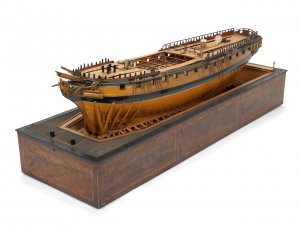

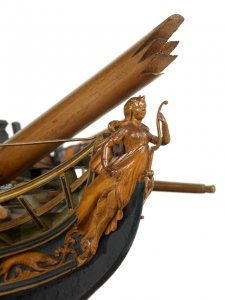

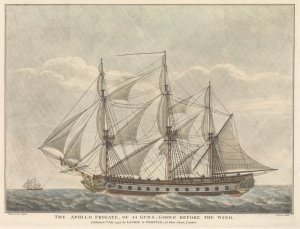
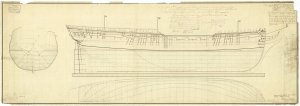
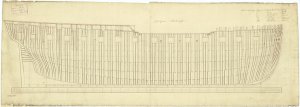


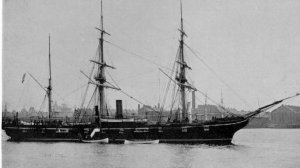
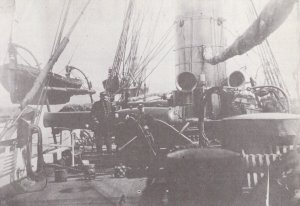
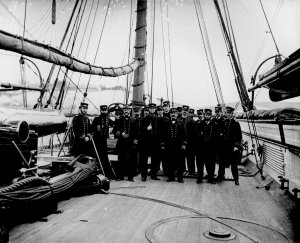
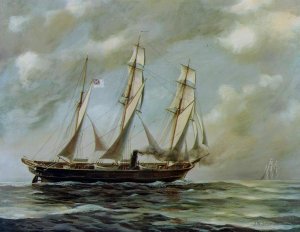





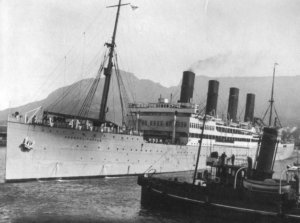
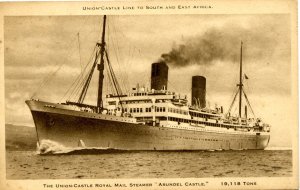
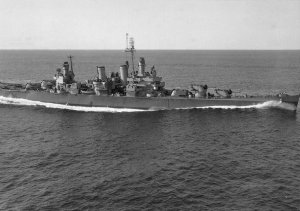

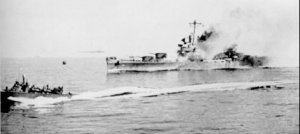

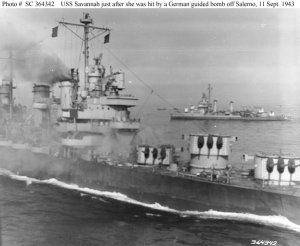

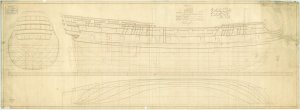
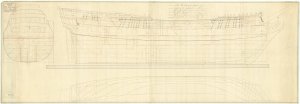

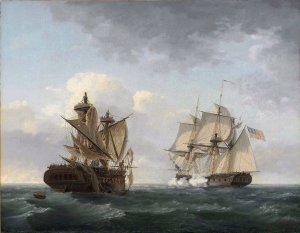


![Plan_de_la_baye_et_[...]Coquart_Antoine_btv1b85966956.JPEG Plan_de_la_baye_et_[...]Coquart_Antoine_btv1b85966956.JPEG](https://shipsofscale.com/sosforums/data/attachments/38/38526-ee72cd395d6c07339359f5a5a2025248.jpg?hash=7nLNOV1sBz)

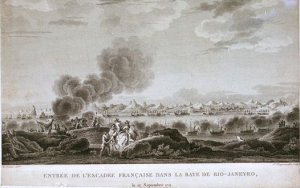

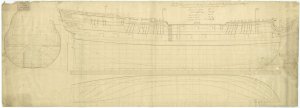
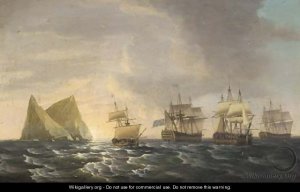


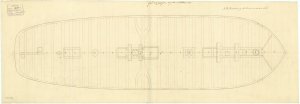
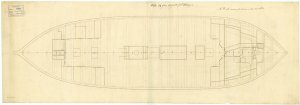


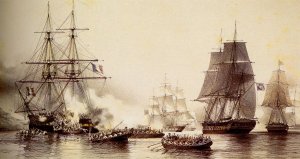
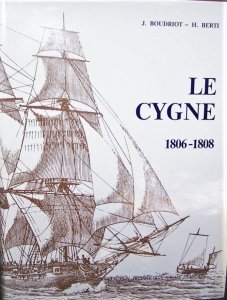
 s
s